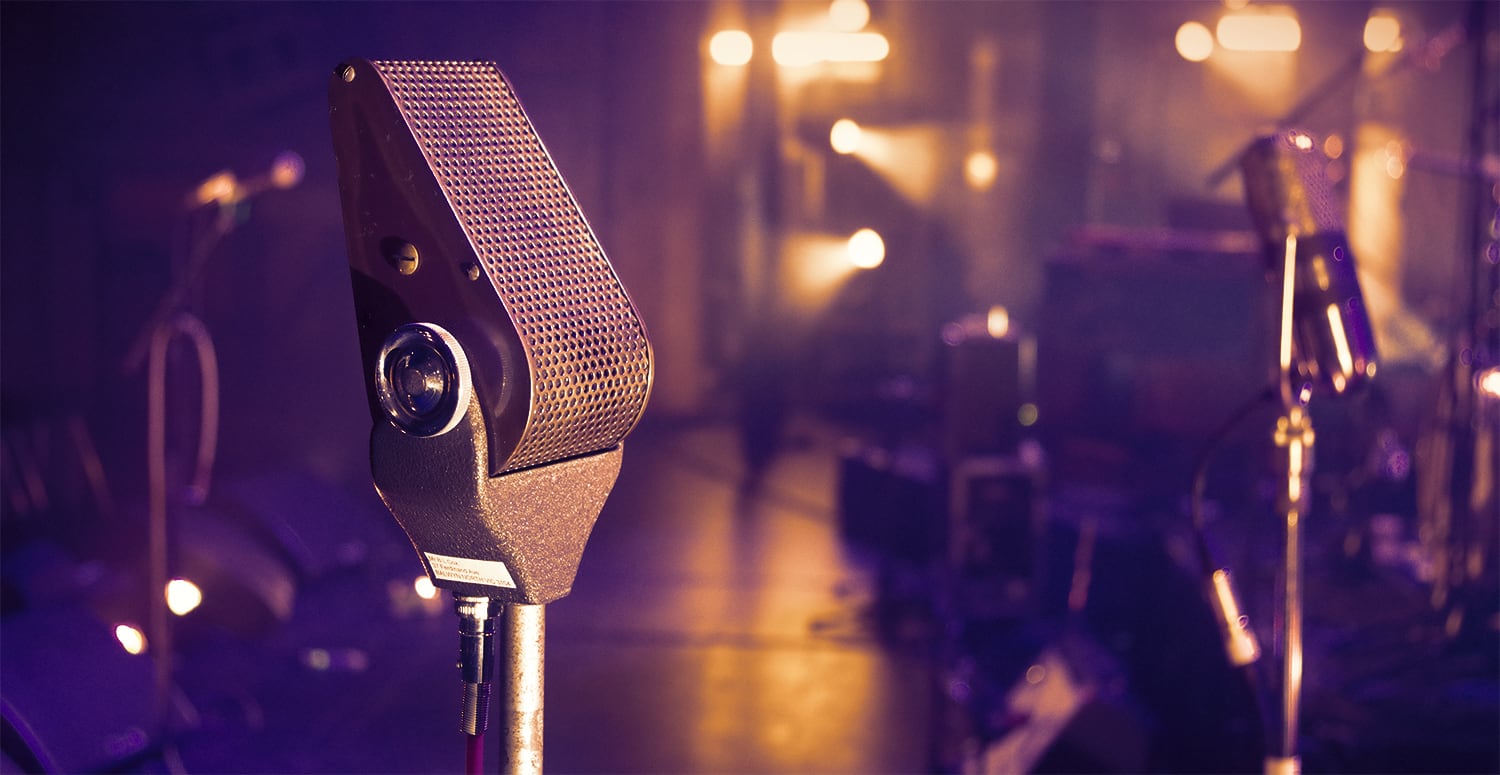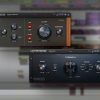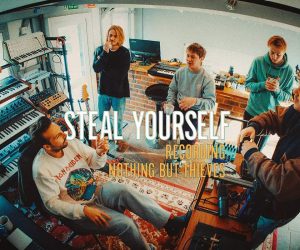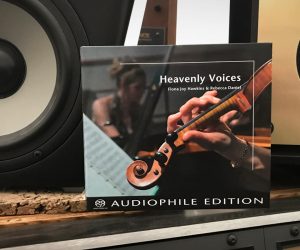
Recording The Teskey Brothers, Live!
The Teskey Brothers are known for the sweet old-school sound of their recordings. Greg Walker catches up with them at Melbourne’s Forum, where they’re recording their shows with three different recording rigs – including an all-analogue rig…
Walking into the Forum Melbourne on a cold Spring afternoon I’m looking for Naomune Anzai (Nao to his friends), production manager and FOH mix engineer for the Teskey Brothers.
Recently renovated and restored to its original beauty, the Forum’s inside is resplendent in gothic glory with Greco-Roman spires and turrets looming against a starry dark blue ‘sky’ – reminding me yet again of what a special venue it is. Underneath the proscenium arch this evening something equally special is taking place: the Teskey Brothers are playing a fourth sold-out show, and behind the scenes there are no less than three recording rigs capturing every note – one of them recording to analogue tape. If there’s any band that can take on this challenge successfully, it’s the Teskey Brothers with their hard-wired classic soul sound and passion for old-school sonics and recording techniques.
Nao Anzai is a key figure in the Teskey Brothers story, having shown Sam Teskey how to get the best out of a Tascam eight-track tape recorder many years ago, and thereby firing his interest in analogue recording. While acting as a mentor in the early days, Nao is very much steering the overall Teskey production ship and brings a flexible yet purist approach to FOH mixing. He specifies a fully analogue Midas Heritage console for as many shows as he can, including this run of dates at the Forum.
I arrived before Nao and had the fortune of taking a tour around the stage with Sam Teskey, looking at the numerous mics in use. After that, we ended up in the small makeshift control room where Alex Bennett had set up the analogue-only recording rig. We were soon joined by Matt Duffy, who was running the main digital recording system, and, of course, Nao Anzai. As we begin what turns out to be a long conversation about gear, recording techniques and the joys and challenges of tracking to analogue tape, I was struck by the warmth and respect in the house. These people obviously enjoy each other’s company and feed off each other’s skillsets in a very positive way. It seems like a perfect blend of personalities with Sam’s enthusiasm and know-how, Nao’s experience and deep technical knowledge, Matt’s proficiency in location recording, and Alex’s fearless commitment to an all-analogue approach. There’s a lot to discuss and also a lot of practical ‘runs-on-the-board’ know-how to tap into…
THREE RECORDING RIGS
While it’s not unusual to record a live show these days, there can’t be many bands (or crews for that matter) up for the challenge of running three rigs at once; let alone one of them using the one-inch eight-track analogue tape format…
Greg Walker: Why are you using three recording rigs?
Sam Teskey: We initially planned to record the Forum concerts digitally from the live mics through the FOH console, to accompany the filming we were doing. There were some compromises involved in that approach, however, so we decided to use it as a back-up rig and bring in a separate digital system dedicated to recording for the filming. That rig takes a split from the live mics. It’s helpful for the filming because we can make a really hi-fi mix from it and sync and edit things easily.
Greg Walker: What were the compromises with recording from the FOH console?
Nao Anzai: It’s mostly about the track count… From the Midas Heritage FOH console I’ve got a total of 16 tracks going into Reaper through a UAD Apollo Quad interface, with a Presonus Digimax providing the extra ADAT inputs. I’m running four channels Direct Out of the console, along with 12 group outputs that include, of course, some submixes. I’ve also got a pair of Røde NT3s at the back balcony for room mics, taking my total track count up to 18.
Matt Duffy: In comparison, I’ve got every line off stage coming into its own Pro Tools channel, along with my own room mics. I’ve got 26 channels going into two Focusrite Clarett interfaces, and another eight channels (mainly spares) coming through an old Zoom R16 interface. So all up I’ve got 34 channels of recording, with no groups or submixing…
Greg Walker: What made you choose the Claretts, Matt?
Matt Duffy: There’s not that many decent interfaces on the market that have lots of channels; there’s a big gap between the portable rigs and non-moveable studio set-ups. I do a lot of location recordings where I’ll go out to a house in the middle of nowhere with a band, and the Clarett did a great job – the preamps are really good. So when I wanted to expand my set-up I bought another one. They’re really stable and easy to set up together.
Greg Walker: Sam, why did you decide to go with the analogue recording rig as well?
Sam Teskey: We’d already decided to have the two digital recording rigs for the purposes of the video, as we’ve just talked about, but from a purely recording point of view we thought “why not go to analogue tape as well for a possible vinyl release?” And instead of splitting all the lines again for the analogue recording rig – which would have meant about four different splits from the live mics [FOH, monitors, digital recording rig, analogue recording rig] – we did it the old fashioned way with totally separate mics and lines for the analogue recording rig, and doing things like taping two vocal mics together. It looks like the old Jimi Hendrix live footage with all these recording mics taped on top of the PA mics!
Alex Bennett: And because the analogue rig is using totally separate mics, I can choose mics and placements specifically for the desired sound without worrying about feedback or spill.
Greg Walker: Is the analogue recording rig sharing any of the live mics?
Sam Teskey: There are a few extras like the banjo and acoustic guitar that only appear for one song so we take a split off the live mics for those things, but that’s about it. We decided that having one or two more mics on stage just for those short moments might be one or two mics too many…
Alex Bennett: I’ve only got eight tracks for recording, but I’ve got 24 lines coming off stage. I’m taking 12 of those lines into an old ‘70s Chilton console and submixing them to four buses to record on to four tracks: drums, backing vocals, horns and keyboards. The bass and the lead vocal go directly to their own tracks, while the guitars are mixed and matched through preamps to the last two tracks. Sometimes I have to do some fast re-patching for the banjo and other things that only appear in one song.
Matt Duffy: He’s mixing some things down to one channel, re-patching things between songs and also changing reels. He’s really been working flat out!
Sam Teskey: Every night we’ve been changing the setlist to keep it pretty fresh for the band, but that’s been a bit of a headache for everyone on the crew. Before we go onstage we’ll tell Alex “we’re going to change things a bit so you’ll have to re-patch an instrument or change a reel here instead of there.” We add ‘reel change’ to the set list so we all know when he’s changing a reel and can give him time to do it. It’s been challenging, but we’ve become a tightly oiled machine.
Why not go to analogue tape as well for a possible vinyl release?
ANALOGUE RECORDING RIG
When the Teskey Brothers decided to bring in an analogue recording rig, they decided to go very analogue – right down to using vintage consoles, preamps and compressors, custom-made equipment, analogue tape, and signal paths full of tubes and transformers…
Greg Walker: Tell me about the analogue recording rig, Alex…
Alex Bennett: A lot of the gear here is mine. We hired the 12-channel Chilton QM3 console off a guy who was selling it. He was happy to hire it to us, and it’s perfect for our needs. The rack on the lower left was wheeled straight out of Sam’s studio, and I also grabbed a few other things from his place. I’m using his Chandler preamps on the guitars.
Sam Teskey: I love the Chandlers on guitars. In the studio I set it so it hits the tape hard and when you really rip into the guitar you can hear the top end break up a little. The other thing I’ve been doing with the Chandlers is plugging the guitar straight into one unit, getting that real direct electric sound and then patching it straight into the other channel, then into the tape machine. You get some really crazy, huge and weird sounds doing that, and you’ve got so much control with the EQs.
Greg Walker: What about the Giles Audio valve preamp?
Alex Bennett: That’s on the bass and it’s going into the Giles Audio valve compressor. It’s quite a slow compressor, but I think it’s got about the right timing for most of the Teskey Brothers’ songs. I’m slowing it down maybe one or two clicks for a couple of songs.
Sam Teskey: It’s also really handy because you can turn off the compressor circuit and just use the extra gain stage. It’s a handy tool in the studio. It’s really quick and easy to just click it off and crunch things up a bit – especially with something like the Giles Audio preamp that only has an input gain control; the compressor gives you much more output gain control, so they’re handy together.
Greg Walker: I see a Universal Audio LA610 channel strip there. What is that being used for?
Alex Bennett: That’s also Sam’s. I’m using it for the trumpets; there’s a ribbon mic out there for the trumpets, and the LA610 let’s me give it just a bit of high shelf EQ brightness that works well on brass.
Sam Teskey: That’s something I’ve always had. It often ends up on Josh’s vocal just because it’s so easy to dial up. Our first album was all done on that. The Giles Audio preamp has a bit more fidelity and a big valve sound, but the Universal Audio LA610 is more of a character thing.
Greg Walker: What else do you have in this rig?
Alex Bennett: I use a lot of Ekadek gear, made by Greg Brice; he’s a friend of mine who lives in New Zealand. He customised my mixing console, and he’s made a lot of boxes for my studio. We’re testing out a prototype preamp of his on this gig; it’s kind of a Neve-ish vibe with a 1080-style EQ section. [Points to items in rack.] He also built this VariMu compressor and this two-channel valve preamp with an EQ stage – it’s got tons of gain and switchable input impedances so you can choose the right impedance for the right ribbon mic. Also, it has no phantom power so you can’t blow up your old ribbons!
Greg Walker: And the tape machine is yours?
Alex Bennett: Yeah. It’s an MCI JH 114 one-inch eight-track analogue tape recorder. We had a balanced/unbalanced issue while connecting it to the Chilton console but I got to the bottom of that. The console has transformers on the microphone inputs but not on the outputs, which is no big deal – the preamps are nice and that’s all that matters to me. The bussing section is good too. It’s really the perfect console format for this job.
Greg Walker: I assume you’re using a fair bit of tape…
Alex Bennett: Over the four shows we’ll end up going through 12 reels of tape. It’s RTM 911 formulation, which is the modern equivalent of the old 456 tape. I’m running it at 15ips, with IEC equalisation at 410nW/m, and I’m not using any noise reduction.
Greg Walker: 12 reels? That’s three reels per show. With all the submixing, patching and reel changes required, I guess you’re busy the whole time!
Alex Bennett: Yeah. Although the submixing is pretty intuitive. The drum bus doesn’t change too much but every now and then I’ll need more or less kick, give it some more bottom end or whatever. The drums are being captured with just four mics and they’re going down to one track on tape, so I’ll ride the subgroup fader depending on the dynamics of Liam’s playing; feed it a bit more in the quieter sections, or give it more headroom if I know he’s about to go wild. I’m trying not to crush the busses too much, I want to keep it snappy in the dynamics. Do you want to hear something?
[At this point Alex tees up a reel with a freshly tracked version of ‘So Caught Up’ from the night before. The track that greets our ears through the small Genelec monitors sounds great; it’s got a deep throaty analogue character to it, and Alex has captured the quality and energy of the sounds beautifully.]
Sam Teskey: If the performances are there I reckon we’ve got it!
MICROPHONES
With 34 lines coming into the digital recording rig along with the additional mics in place for the analogue recording rig, there’s obviously a lot of mics on stage. The following focuses on some of the more interesting choices, and particularly those being used for the analogue recording…
Greg Walker: On stage I saw some ribbon mics that looked like they were for the brass section…
Sam Teskey: Yeah. They’re only for the recording; one of them looks like a cheese grater!
Alex Bennett: There’s an RCA 77DX and a Steanes Sound Systems R47 – that’s the one Sam called a ‘cheese grater’! (laughs) It’s actually an old Australian ribbon mic, manufactured in Melbourne in the ‘40s or ‘50s. The two trumpets go into the RCA, and the trombone goes into the Steanes. Those ribbons are also acting like room mics for me because they’re quite far away from the horns and their rear lobes face the audience.
Nao Anzai: As an indication of distance, for FOH I’m using a Shure Beta 57 for the trumpets and a Peavy PVM520i for the trombone, and Alex’s mics are about a metre further back than mine.
Alex Bennett: They’re working out great because I need to keep it simple and I don’t have room for the dedicated room mics that Matt is using in the digital recording system.
Greg Walker: What are the room mics you’re using, Matt?
Matt Duffy: They’re Electro-Voice 635A omnidirectional dynamics. Classic ‘70s mics…
Alex Bennett: They’re the same era as the Electro-Voice RE16s I’ve got strapped on to the vocal mics for the analogue recording.
Sam Teskey: There’s a lot of Electro-Voice mics on stage. For tonight we’ve got two guest backing vocalists, and each of them has a Shure SM58 for the live mix with an Electro-Voice mic taped on to it for the analogue tape recording. Electro-Voice’s RE16 and DS35 are very similar mics and we’re using them as recording mics for the vocals across the front – Alex tried a few different options and liked them the best. Backing vocals for the drums and bass are AKG D190Cs, another old classic.
Greg Walker: Speaking of classic AKGs, I saw some D12s on stage…
Sam Teskey: Yes. We’re using a D12 on the bass amp, and another on the kick.
Alex Bennett: The D12 on the kick is for the analogue recording, along with a Sennheiser 441 on snare – l love that mic! I’ve also got two modified RFT Gefell MV101s set up in an old-school placement where they’re capturing a lot of rack tom and floor tom while also doing the overhead job.
Sam Teskey: When you’ve only got four mics to record a kit it’s important to get that balance right.
Nao Anzai: It also helps to have a super balanced drummer like Liam! On most of the quiet songs I’m just using my kick drum mic (Shure Beta 52) and my overheads (Shure KSM32s) through FOH and it’s sounding great. But I can only do that because Liam is a super balanced drummer. I don’t need to worry about cymbal spill or whatever, everything is completely fine because of his playing.
Greg Walker: What about the guitar amps? I saw some vintage Sennheiser 421s there – the old white ones – and some of those Shure ribbons, the black and red ones…
Sam Teskey: I love those old white 421s on my guitar amp, they sound completely different to the black ones. They’re great for guitar amps.
Nao Anzai: Agreed! I’ve got one of those early white 421s; they’re great mics. They were completely discrete and hand-made. Later, after the white ones got a good reputation, they moved to a bigger factory and mass produced the black ones. The white ones were almost more like a prototype, made in small runs by hand.
Sam Teskey: My favourite for guitar amps in the studio is a Coles 4038 ribbon off the cab a bit, but they’re a really sensitive mic and you can’t use them up close to an amp in a live setting because they break up. That’s why we’re using the modern Shure KSM313 ribbon mics – the black and red ones.
Nao Anzai: The best thing about those Shure ribbons is that they’re built tough for live performance. It’s really hard to break one. I didn’t want to use ribbons for these gigs but they said “no, these ones are fine.” I tested them and they’ve been great. I’m also miking the guitar amps with Shure SM57s.
Greg Walker: What about the keyboards?
Sam Teskey: We’ve got an old organ using a Leslie speaker, but there’s also a modern keyboard, a Nord; we put that through a Fender amp to match the tones a little.
Alex Bennett: We couldn’t just DI the Nord because both it and the organ [miked up through the Leslie] are going to the same tape track, and they had completely different textures. Running the Nord through the amp brings it a little closer to the texture of the Leslie. For recording, I miked that amp with a Sennheiser 441, and the Leslie with an ElectroVoice RE20. The RE20 also acts as a bit of a room mic because it faces the audience.
Sam Teskey: Because we’ve got mono drums for the analogue recording hopefully these more roomy mics – from the brass on one side of the stage and the keyboard amps on the other side – will open up the stereo image a bit more, so it’ll be punchy in the middle and more spacious on the sides.
GOING ANALOGUE…
Sam Teskey, Alex Bennett and Nao Anzai talk about tape recorders, tape formulations, mixing and mastering…
Greg Walker: How did this passion for using analogue tape begin, Sam?
Sam Teskey: Around 13 years ago, when my set-up was pretty much just a home studio, I borrowed an eight-track Tascam tape machine and Nao showed us how to sync it to Cubase and Nuendo. I was learning heaps by watching Nao work with the tape machine, and after a while he happened to be selling one of his eight-tracks. I bought it and used it for years. Later on I bought the Studer 24-track we use now, which is quite a hi-fi machine, but it brought with it a whole new level of learning, maintenance and calibration that I needed to understand, whereas the Tascam was just really solid and simple – I think I only had it serviced once a year.
Nao Anzai: I used that Tascam machine for mastering; for bouncing mixes from the computer to tape. I would set it up so that the first two tracks were hitting at a moderate level with noise reduction, the second two tracks at super hot levels with noise reduction, the third two tracks at moderate levels with no noise reduction, and the last two tracks at super hot levels with no noise reduction. Then I’d bounce it all back into the computer and rebalance the song part by part – in the quiet parts I’d use the noise reduction tracks more, then blend the other tracks up in the mix for the louder sections and get more tape compression as well. Before I had a decent master compressor, I used the tape machine like that. I stopped using analogue tape for mastering about five years ago when I couldn’t get any more of the original 499 and 456 tapes…
Alex Bennett: You don’t like the new tapes they’re making now?
Nao Anzai: I think they’re fine for tracking, but mastering is a different thing; also a lot of my clients now don’t like the hiss. The other thing that changed for me was Universal Audio’s Ampex ATR102 tape machine plug-in. With that you can decide, on the fly, which tape formulation is better for which song, which tape speed is better, whether or not you want a transformer output, and so on. Song by song you can just switch these things on or off. This completely blew my mind, because when you’re using a real analogue tape machine these are the things you have to decide before you start the mastering session. Calibration took a long time so you couldn’t make changes on the fly, but with the plug-in now you can and this has given me a huge advantage.
Sam Teskey: Plug-ins are good, but I love Alex’s approach to recording and mixing too. I really admire the fact that he doesn’t use computers at all. When we started working together I said to him, ‘Do some mixes, we’ll listen to the digital bounces and give you some feedback’, but it’s much harder to work in that digital ‘mix, save, revise’ manner with a fully analogue system. So Alex would say, ‘Just come to the studio for three days and we’ll mix it all together’…
Alex Bennett: Then it’s done!
Sam Teskey: Yeah, then it’s done!
Greg Walker: Speaking of mixing… Sam, when this all wraps up will you be mixing the analogue recordings yourself?
Sam Teskey: No I’m going to keep it in Alex’s hands because he’s the mastermind of this whole analogue set-up. He’ll take it back to his studio in Castlemaine where there’s no computer, and he’ll mix it direct down to 1/4-inch tape. I’ll probably go there for a few days and work on the mixes with him, acting more as a musician. We’ll mix as much of the good stuff as we can and then take it to Crystal Mastering in Melbourne to transfer it to digital format so we can share the mixes between ourselves, listen to them and decide which ones we want for the live album. We can only fit 45 minutes on a vinyl release, but if the recordings go really well there’s room to maybe do a deluxe edition or a double LP. Or maybe we’ll just release the full version on Spotify… But all of that is for later; for now I’m really focusing on the shows and keeping my head out of this other stuff as much as I can…
BACK TO WORK
The discussion comes to a timely halt when soundcheck is called. I spend a bit more time at front of house with Nao, where he points out a portable Zoom recorder that he’s rigged up to catch extra crowd ambience for his Reaper recordings – another example of the happy blend of technologies being roped in to achieve the desired result.
Later that night the Teskey Brothers play a soulful show to another sold-out audience. The live sound is sweet and full and has a relaxed quality that is pretty rare at a live gig these days. It’s not super loud or sub-heavy, inviting the audience in rather than beating them into submission. Nao is perched at the FOH mixing position and, true to his word, the drums do sound great with just the overhead mics and a bit of kick. It’s yet another example of how the band and crew back their audio philosophies with carefully considered actions that really do buck the trend of contemporary studio and live production. As the awards and accolades continue to accumulate there’s no doubting it’s an approach that’s paid off big time.


























Choosing a quality microphone – this is not a trivial task, which can successfully be solved thanks to a scrupulous study and a detailed comparison of the main varieties of the microphones, their characteristics, and functional features. To determine exactly what kind of the microphone you need, you must clearly define your goals and objectives.
From the purposes for which you need a microphone (e.g., for stereo recording, for recording vocals or musical instruments) will depend the fact on which model you will finally focus.